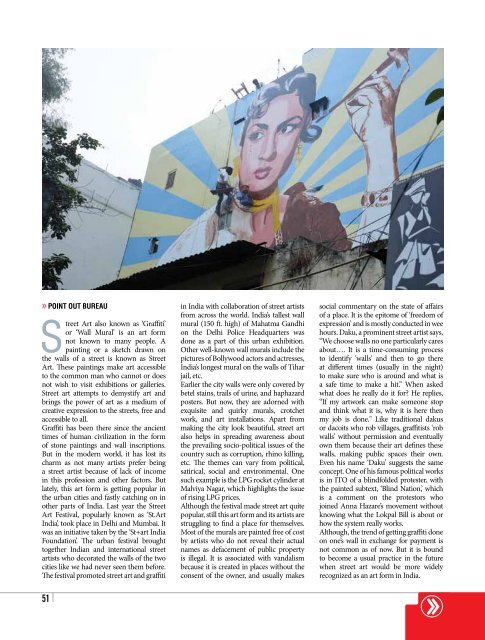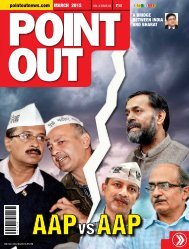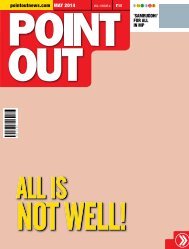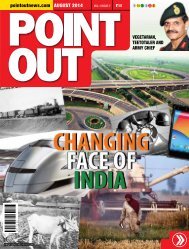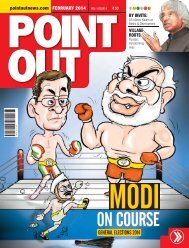MAY 2015
Create successful ePaper yourself
Turn your PDF publications into a flip-book with our unique Google optimized e-Paper software.
»»<br />
point out bureau<br />
S<br />
treet<br />
Art also known as ‘Graffiti’<br />
or ‘Wall Mural’ is an art form<br />
not known to many people. A<br />
painting or a sketch drawn on<br />
the walls of a street is known as Street<br />
Art. These paintings make art accessible<br />
to the common man who cannot or does<br />
not wish to visit exhibitions or galleries.<br />
Street art attempts to demystify art and<br />
brings the power of art as a medium of<br />
creative expression to the streets, free and<br />
accessible to all.<br />
Graffiti has been there since the ancient<br />
times of human civilization in the form<br />
of stone paintings and wall inscriptions.<br />
But in the modern world, it has lost its<br />
charm as not many artists prefer being<br />
a street artist because of lack of income<br />
in this profession and other factors. But<br />
lately, this art form is getting popular in<br />
the urban cities and fastly catching on in<br />
other parts of India. Last year the Street<br />
Art Festival, popularly known as ‘St.Art<br />
India’, took place in Delhi and Mumbai. It<br />
was an initiative taken by the ‘St+art India<br />
Foundation’. The urban festival brought<br />
together Indian and international street<br />
artists who decorated the walls of the two<br />
cities like we had never seen them before.<br />
The festival promoted street art and graffiti<br />
51<br />
in India with collaboration of street artists<br />
from across the world. India’s tallest wall<br />
mural (150 ft. high) of Mahatma Gandhi<br />
on the Delhi Police Headquarters was<br />
done as a part of this urban exhibition.<br />
Other well-known wall murals include the<br />
pictures of Bollywood actors and actresses,<br />
India’s longest mural on the walls of Tihar<br />
jail, etc.<br />
Earlier the city walls were only covered by<br />
betel stains, trails of urine, and haphazard<br />
posters. But now, they are adorned with<br />
exquisite and quirky murals, crotchet<br />
work, and art installations. Apart from<br />
making the city look beautiful, street art<br />
also helps in spreading awareness about<br />
the prevailing socio-political issues of the<br />
country such as corruption, rhino killing,<br />
etc. The themes can vary from political,<br />
satirical, social and environmental. One<br />
such example is the LPG rocket cylinder at<br />
Malviya Nagar, which highlights the issue<br />
of rising LPG prices.<br />
Although the festival made street art quite<br />
popular, still this art form and its artists are<br />
struggling to find a place for themselves.<br />
Most of the murals are painted free of cost<br />
by artists who do not reveal their actual<br />
names as defacement of public property<br />
is illegal. It is associated with vandalism<br />
because it is created in places without the<br />
consent of the owner, and usually makes<br />
social commentary on the state of affairs<br />
of a place. It is the epitome of ‘freedom of<br />
expression’ and is mostly conducted in wee<br />
hours. Daku, a prominent street artist says,<br />
“We choose walls no one particularly cares<br />
about…. It is a time-consuming process<br />
to identify 'walls' and then to go there<br />
at different times (usually in the night)<br />
to make sure who is around and what is<br />
a safe time to make a hit.” When asked<br />
what does he really do it for? He replies,<br />
“If my artwork can make someone stop<br />
and think what it is, why it is here then<br />
my job is done." Like traditional dakus<br />
or dacoits who rob villages, graffitists ‘rob<br />
walls’ without permission and eventually<br />
own them because their art defines these<br />
walls, making public spaces their own.<br />
Even his name ‘Daku’ suggests the same<br />
concept. One of his famous political works<br />
is in ITO of a blindfolded protester, with<br />
the painted subtext, ‘Blind Nation,’ which<br />
is a comment on the protestors who<br />
joined Anna Hazare’s movement without<br />
knowing what the Lokpal Bill is about or<br />
how the system really works.<br />
Although, the trend of getting graffiti done<br />
on one’s wall in exchange for payment is<br />
not common as of now. But it is bound<br />
to become a usual practice in the future<br />
when street art would be more widely<br />
recognized as an art form in India.


